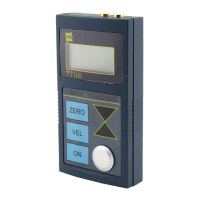
Do you have a question about the Time TT100 and is the answer not in the manual?
| Type | Portable Hardness Tester |
|---|---|
| Display | LCD |
| Memory | 500 groups |
| Impact Device | D-type |
| Materials | Steel, Stainless Steel |
| Measuring Range (HV) | 80-1042 HV |
| Measuring Range (HS) | 30-110 HS |
Details the handheld gauge's application for measuring thickness of various materials and monitoring corrosion.
Explains the ultrasonic wave reflection principle used for thickness measurement.
Lists the main components and refers to diagrams for detailed part descriptions.
Details display type, measurement range, accuracy, operating temperature, power, and dimensions.
Guides on connecting the probe and powering on the unit before measurement.
Explains how to adjust the sound velocity setting using the VEL and arrow keys.
Details the critical calibration process required after probe or battery changes.
Procedure for measuring thickness when the material's sound velocity is known.
Method for measuring sound velocity using a test piece of known thickness.
Describes how to set sound velocity and enter the thickness memory mode.
Explains how to access and view previously stored thickness measurements.
Details the BATT indicator and the procedure for replacing batteries.
Lists important handling, care, and environmental precautions for the unit.
